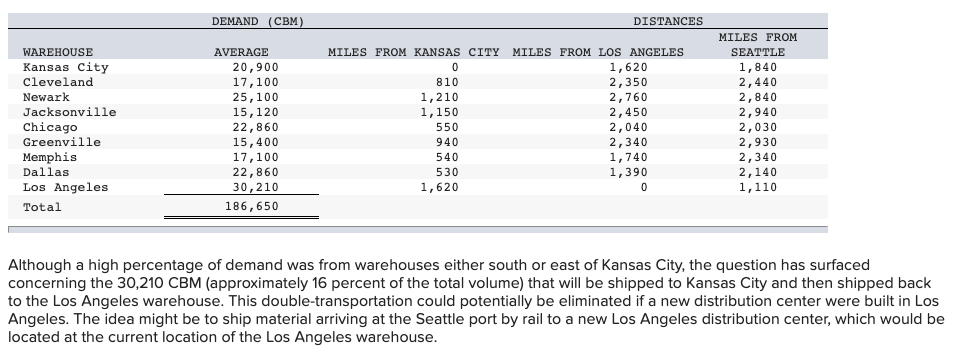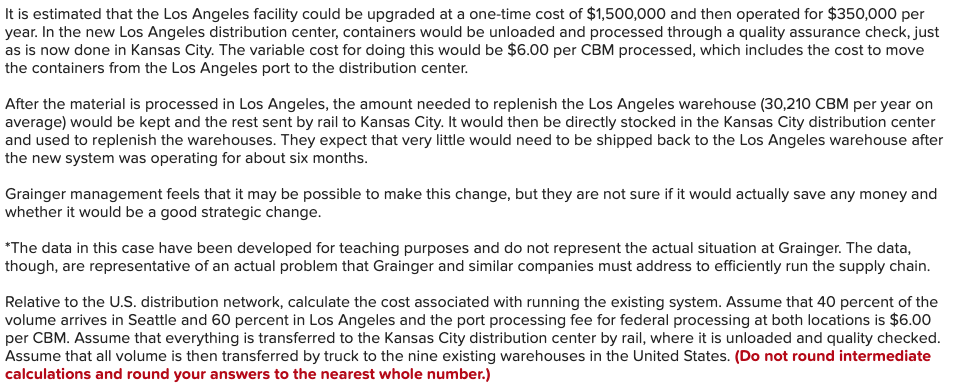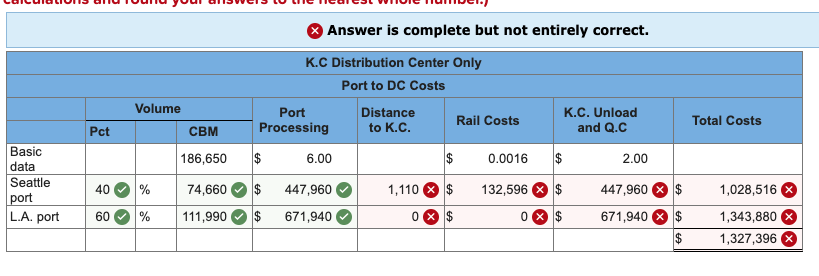





Grainger: Reengineering the China/U.S. Supply Chain W. W. Grainger, Inc., is a leading supplier of maintenance, repair, and operating (MRO) products to businesses and institutions in the United States, Canada, and Mexico, with an expanding presence in Japan, India, China, and Panama. The company works with more than 5,000 suppliers and runs an extensive website (www.grainger.com) where Grainger offers nearly 1.5 million products. The products range from industrial adhesives used in manufacturing, to hand tools, janitorial supplies, lighting equipment, and power tools. When something is needed by one of its customers, it is often needed quickly, so quick service and product availability are key drivers to Grainger's success. Your assignment* involves studying U.S. distribution in Grainger's supply chain. Grainger works with over 250 suppliers in the China and Taiwan region. These suppliers produce products to Grainger's specifications and ship to the United States using ocean freight carriers from four major ports in China and Taiwan. From these ports, product is shipped to U.S. entry ports in either Seattle, Washington, or Los Angeles, California. After passing through customs, the 20- and 40-foot containers are shipped by rail to Grainger's central distribution center in Kansas City, Kansas. The containers are unloaded and quality is checked in Kansas City. From there, individual items are sent to regional warehouses in nine U.S. locations, a Canada site, and Mexico. Grainger: U.S. Distribution In the United States approximately 40 percent of the containers enter in Seattle, Washington, and 60 percent at the Los Angeles, California, port. Containers on arrival at the port cities are inspected by federal agents and then loaded onto rail cars for movement to the Kansas City distribution center. Variable costs for processing at the port are $6.00 per cubic meter (CBM) in both Los Angeles and Seattle. The rate for shipping the containers to Kansas City is $0.0016 per CBM per mile. In Kansas City the containers are unloaded and processed through a quality assurance check. This costs $2.00 per CBM processed. A very small percentage of the material is actually sent back to the supplier, but errors in quantity and package size are often found that require accounting adjustments. Items are stored in the Kansas City distribution center, which serves nine warehouses in the United States. Items are also sent to warehouses in Canada and Mexico, but for the purposes of this study we focus on the United States. The nine warehouses each place orders at the distribution center that contains all the items to be replenished. Kansas City picks each item on the order, consolidates the items onto pallets, and ships the items on 53-foot trucks destined to each warehouse. Truck freight costs $0.03 per CBM per mile. The demand forecasts for the items purchased from China/Taiwan for next year in cubic meters and shipping distances are given in the following table. DEMAND (CBM) DISTANCES WAREHOUSE Kansas City Cleveland Newark Jacksonville Chicago Greenville Memphis Dallas Los Angeles Total AVERAGE 20,900 17,100 25,100 15,120 22,860 15,400 17,100 22,860 30,210 186,650 MILES FROM KANSAS CITY 0 810 1,210 1,150 550 940 540 530 1,620 MILES FROM LOS ANGELES 1,620 2,350 2,760 2,450 2,040 2,340 1,740 1,390 0 MILES FROM SEATTLE 1,840 2,440 2,840 2,940 2,030 2,930 2,340 2,140 1,110 Although a high percentage of demand was from warehouses either south or east of Kansas City, the question has surfaced concerning the 30,210 CBM (approximately 16 percent of the total volume) that will be shipped to Kansas City and then shipped back to the Los Angeles warehouse. This double-transportation could potentially be eliminated if a new distribution center were built in Los Angeles. The idea might be to ship material arriving at the Seattle port by rail to a new Los Angeles distribution center, which would be located at the current location of the Los Angeles warehouse. It is estimated that the Los Angeles facility could be upgraded at a one-time cost of $1,500,000 and then operated for $350,000 per year. In the new Los Angeles distribution center, containers would be unloaded and processed through a quality assurance check, just as is now done in Kansas City. The variable cost for doing this would be $6.00 per CBM processed, which includes the cost to move the containers from the Los Angeles port to the distribution center. After the material is processed in Los Angeles, the amount needed to replenish the Los Angeles warehouse (30,210 CBM per year on average) would be kept and the rest sent by rail to Kansas City. It would then be directly stocked in the Kansas City distribution center and used to replenish the warehouses. They expect that very little would need to be shipped back to the Los Angeles warehouse after the new system was operating for about six months. Grainger management feels that it may be possible to make this change, but they are not sure if it would actually save any money and whether it would be a good strategic change. *The data in this case have been developed for teaching purposes and do not represent the actual situation at Grainger. The data, though, are representative of an actual problem that Grainger and similar companies must address to efficiently run the supply chain. Relative to the U.S. distribution network, calculate the cost associated with running the existing system. Assume that 40 percent of the volume arrives in Seattle and 60 percent in Los Angeles and the port processing fee for federal processing at both locations is $6.00 per CBM. Assume that everything is transferred to the Kansas City distribution center by rail, where it is unloaded and quality checked. Assume that all volume is then transferred by truck to the nine existing warehouses in the United States. (Do not round intermediate calculations and round your answers to the nearest whole number.) Answer is complete but not entirely correct. K.C Distribution Center Only Port to DC Costs Port Distance Processing to K.C. Rail Costs Volume K.C. Unload and Q.C Total Costs Pct CBM 186,650 $ 6.00 $ 0.0016 $ 2.00 Basic data Seattle port L.A. port 40 % $ 1,110 $ 132,596 $ $ 1,028,516 74,660 111,990 447,960 671,940 447,960 $ 671,940 $ 60 % $ 0 $ $ 1,343,880 1,327,396 $ Answer is complete but not entirely K.C Distribution Center Only DC to Warehouse Costs Truck Warehouse Freight Costs Kansas City 0 Cleveland 304,722 Newark 668,162 % Jacksonville 382,536 X Chicago 276,606 > Greenville 318,472 Memphis 203,148 X Dallas 266,548 Los Angeles 0 X Total $ 2,420,194 X Total cost of current 5,198,082 system $












